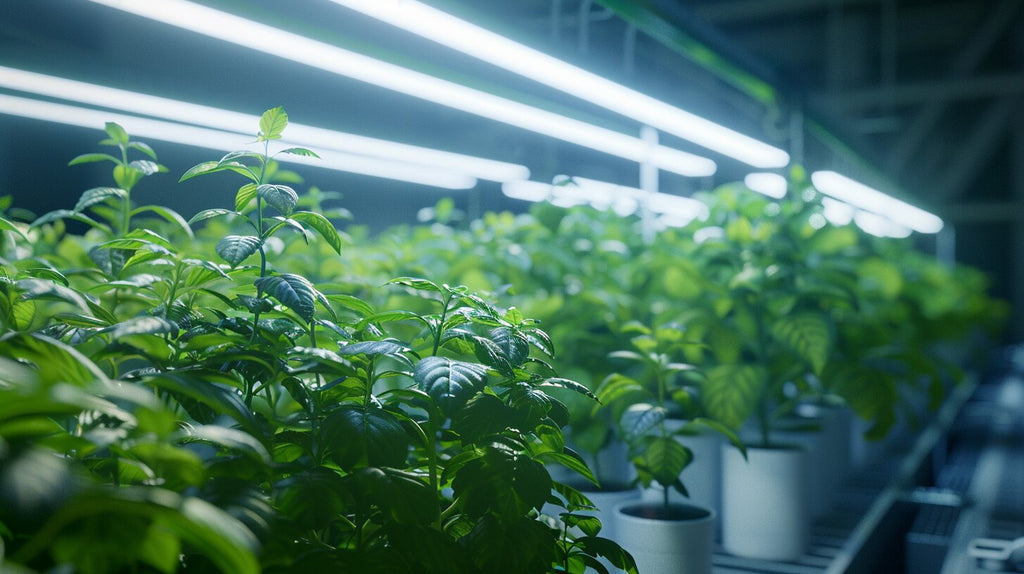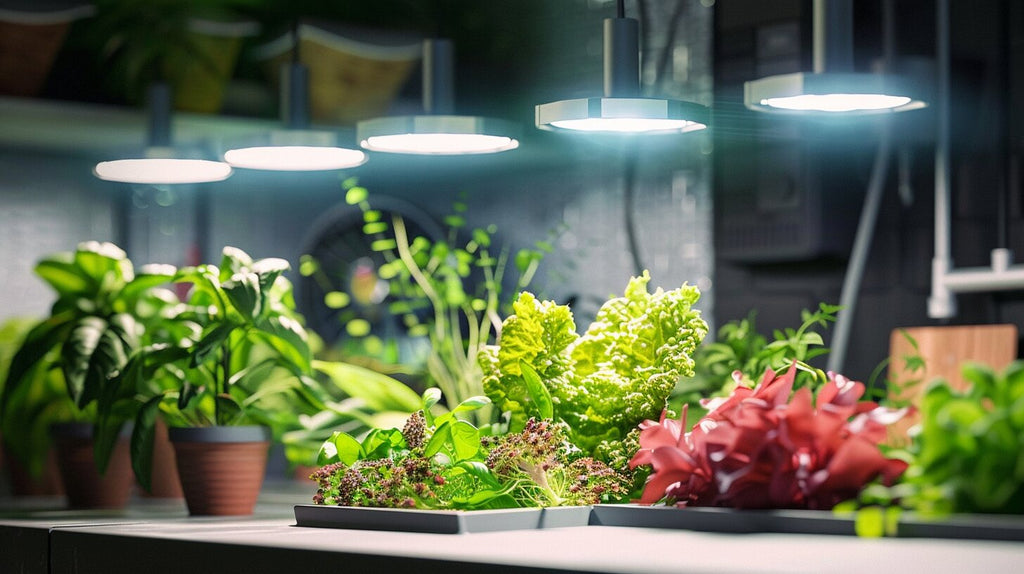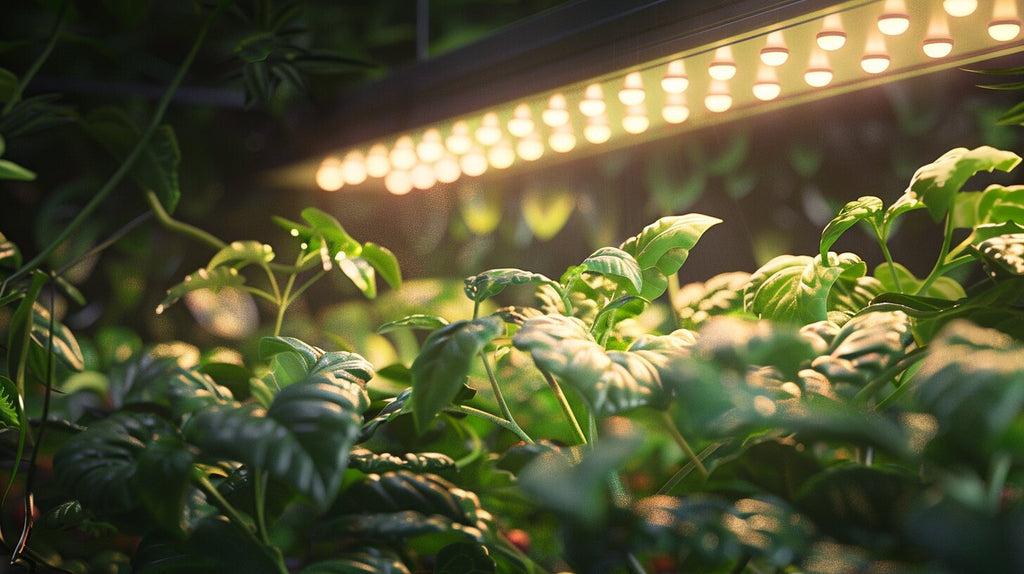
Mastering Blue Cheese Strain Growth: Tips, Tricks, and Review
Choosing the best grow lights for your indoor gardening adventures might seem daunting at first. After all, plants naturally thrive under sunlight, which is why we've always grown them outdoors.
But, with the rise of indoor farming, technology has made leaps and bounds in developing artificial lights that can mimic the sun's nurturing rays.
Now, we find ourselves with a wealth of options for growing healthy plants indoors, away from direct sunlight, using special fixtures known as grow lights.
Whether you're a seasoned indoor farmer or just starting to explore the possibilities of growing plants inside, understanding how to select the right grow light can make all the difference, and it's much simpler than it seems.

When sifting through the myriad of grow light options, it's essential to familiarize yourself with the main types available. These can broadly be categorized into LED (Light Emitting Diode), HID (High-Intensity Discharge), and Fluorescent/T5 lighting systems, each with their subsets and specific use cases.

Selecting the right grow light involves more than just understanding the different types available on the market. It requires carefully considering your indoor garden's specific needs, including the types of plants you wish to grow, the space available, and your budget.
With these considerations in mind, you can narrow down your options and choose a grow light system that suits your garden and optimizes plant growth and health.
Light's intensity and quality are vital for indoor plants' survival and flourishing, closely mimicking the natural sunlight conditions under which plants have evolved. These elements influence the rate of photosynthesis and signal plants to initiate critical growth stages ranging from seed germination to vegetative growth and flowering.
High-intensity light supports photosynthesis, enabling plants to generate the energy needed for growth. However, it's crucial to balance light intensity to avoid scorching or stressing the plants, which can happen with improper placement of high-output lights like HID systems. On the other hand, insufficient light intensity can lead to weak, elongated plants and reduced yield.
The quality or spectrum of light plays a similarly crucial role. Different stages of plant growth require different light spectrums. For instance, blue light promotes leafy growth and is ideal for seedlings and young plants in the vegetative stage. Conversely, red light is beneficial during the flowering stage, encouraging plants to produce flowers and fruit.
So, selecting a grow light system that can offer a spectrum tailored to your plants' current growth stage—or adjustable spectrum capabilities—will significantly impact their health and productivity.
LED grow lights stand out for their energy efficiency, consuming less power and producing less heat than HID lamps. This efficiency translates to lower electricity bills and reduced need for cooling systems, which can add up to significant savings over time.
While LEDs typically have a higher upfront cost compared to HID and fluorescent lights, their long lifespan and lower operating costs make them a more economical choice in the long run. Additionally, the evolving technology and increasing demand for LED grow lights have gradually lowered their prices, making them more accessible to a broader range of gardeners.
Thus, when selecting a grow light, consider not only the purchase price but also the potential energy savings and longevity of the lighting system to ensure you're making a cost-effective decision for your indoor garden.

The spectrum of light, or the colors of light emitted by a grow light, plays a pivotal role in plant development and health. Just as natural sunlight encompasses a wide range of colors, each segment of the light spectrum influences different aspects of plant growth.
Combining these colors to create a full-spectrum light source can offer indoor plants a balanced diet of light, closely mimicking the sun's natural spectrum. Advanced LED grow lights often feature adjustable spectrums, allowing gardeners to tailor the light to their plants' changing needs throughout their life cycle.
The size and layout of your gardening area will significantly influence the type of light you choose, as well as its placement and coverage. Compact spaces, such as countertop gardens or small grow tents, may be well-suited to LED or fluorescent lights, which can provide intense, full-spectrum light without taking up excessive space or generating too much heat.
On the other hand, larger indoor gardens or those with taller plants might benefit from HID systems, particularly if the setup allows for proper ventilation to manage the heat these lights produce.
When planning your indoor garden, it's also important to consider the light coverage area—each type of grow light has a maximum effective range. LEDs, for instance, can be placed closer to plants due to their lower heat output, potentially allowing for a smaller footprint.
Conversely, HID lights need to be installed higher above plants, requiring careful calculation to ensure even light distribution across a wider area.

Growing seedlings demand careful attention to their lighting needs to ensure a robust start in life. Newly emerged seedlings and young plants thrive under full-spectrum light, which combines both blue and red wavelengths essential for their development.
While specialized LED and fluorescent "grow lights" are designed for this purpose, gardeners on a budget can also use less expensive fluorescent tube bulbs to achieve good results.
It's crucial for the light source to be positioned within 6 inches of the plant foliage to maximize growth. For convenience and to accommodate plant growth, consider suspending the light fixture on chains or raising your plants on a platform, such as a table or a DIY seed starting station.
Selecting the right light for flowering plants is paramount in achieving optimal bloom and fruit production. The ideal grow light should offer a spectrum that leans heavily toward the red part of the spectrum, facilitating the flowering stage of plant growth. Among the plethora of options available, three models stand out as particularly effective for flowering plants:
These models provide the essential red and far-red light that encourages plants to enter and thrive in the flowering stage. When investing in a grow light for your flowering plants, it is crucial to consider not just the intensity and spectrum of the light but also the specific needs of your plants and the scalability of your indoor garden.

Once you've selected the ideal grow light for your plants, determining the correct size and intensity for your indoor garden is crucial. Follow these steps to ensure your plants receive the right amount of light:
Determining Light Range:
Consider this process an essential step in creating an optimal growth environment for your indoor garden. Proper lighting, tailored to both the space and the specific needs of your plants, can significantly enhance their growth and vitality.
You can count on our prices to be among the best in the industry. What's more, we also offer free shipping for Canada-wide orders over $149. Visit our online shop and find the best grow lights for your plants at the lowest prices.
Whether you're starting seedlings, nurturing flowering plants, or anything in between, Canada Grow Supplies is your go-to destination for quality and affordability.
Visit our blog regularly to stay connected with the latest in indoor gardening and grow light technology. Our experts share valuable insights, tips, and trends to help you achieve the lush, vibrant indoor garden of your dreams.
For personalized advice, our knowledgeable staff is here to assist you. Whether you're setting up a new indoor garden or looking to upgrade your existing setup, don't hesitate to contact us. Our team is ready to support you in selecting the perfect grow lights and accessories tailored to your specific needs. Your ideal indoor garden is just a click away with Canada Grow Supplies.
Choosing the right indoor grow light involves assessing your plants' specific needs and the size of your growing area. Consider the light spectrum required for your plants' growth stages and aim for a light intensity that matches the wattage recommendations for the square footage of your indoor garden. Always prioritize energy-efficient models to optimize growth while minimizing electricity costs.
The best light for growing plants indoors largely depends on the type of plants and their specific growth stages. Full-spectrum LED lights are widely recognized for their efficiency and ability to emulate natural sunlight, catering to the needs of most indoor plants throughout their lifecycle.
The optimal wattage for indoor grow lights largely varies depending on the plant species and the size of the growing area. Generally, a range of 20 to 40 watts per square foot is recommended for most indoor gardens to ensure sufficient light without causing harm to the plants. Always tailor the lighting choice to the specific requirements of your indoor garden for the best results.
Choosing the best LED grow lights involves considering the light spectrum, intensity, and energy efficiency to suit your indoor garden's specific needs. Look for lights that offer a full spectrum to closely mimic natural sunlight, which is essential for the growth and development of your plants. Additionally, ensure the light's intensity is adequate for your garden's size while being energy-efficient to keep operational costs low.